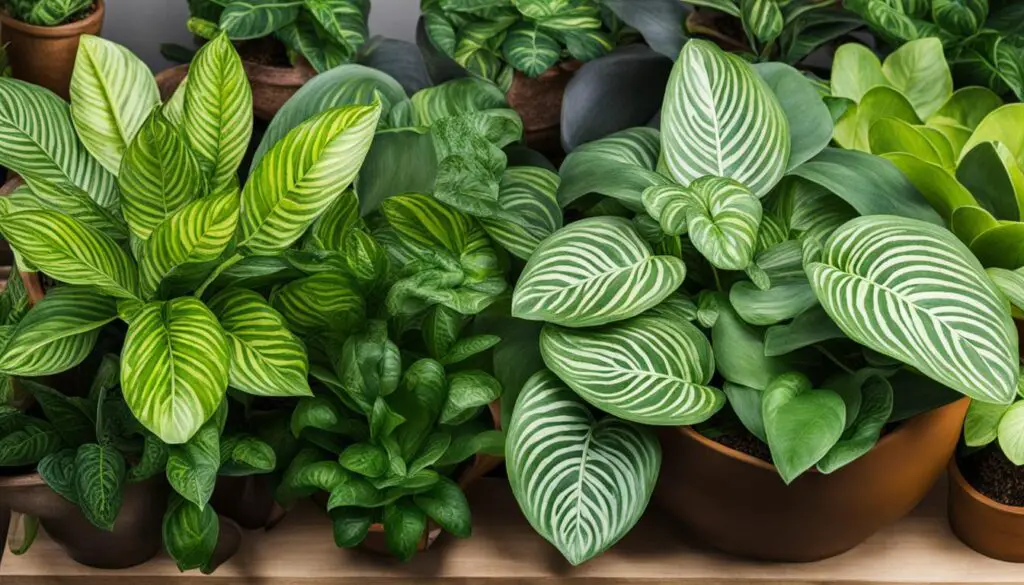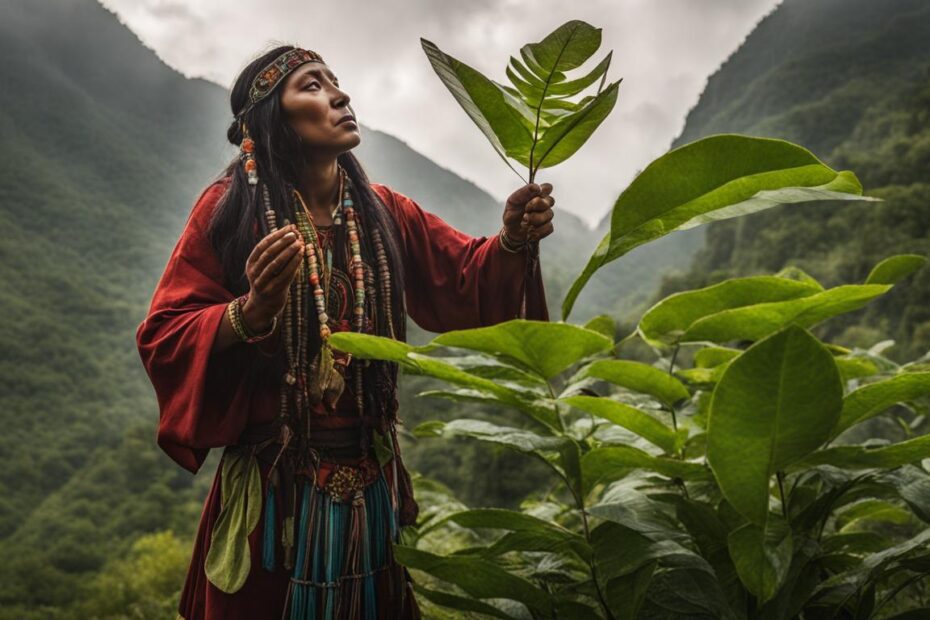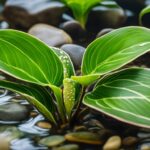The prayer plant, scientifically known as Maranta leuconeura, has a rich and fascinating history. Native to the tropical rainforests of Brazil, this plant has captivated plant enthusiasts around the world with its unique leaf movements and beautiful foliage. Its name comes from the way its leaves fold upwards at night, resembling hands in prayer. In this article, we will delve into the origins of the prayer plant, its historical significance, and how it has evolved over time.
Key Takeaways:
- The prayer plant, Maranta leuconeura, is native to the tropical rainforests of Brazil.
- The unique leaf movements of the prayer plant have been associated with prayer and devotion in many cultures.
- Over time, prayer plants have been selectively bred, resulting in a wide variety of cultivars with different leaf patterns and colors.
- Proper care, including providing bright but indirect light and regular watering, is essential for keeping prayer plants healthy.
- The prayer plant’s rich history and aesthetic appeal have made it a beloved choice for indoor gardening enthusiasts.
Native Habitat and Origins of the Prayer Plant
The prayer plant, scientifically known as Maranta leuconeura, originates from the tropical rainforests of Brazil and other regions in South America. It belongs to the Marantaceae family and thrives in warm and humid conditions. This natural habitat has influenced the plant’s unique characteristics and leaf movements, making it an intriguing specimen for plant enthusiasts.
The prayer plant’s name stems from its distinctive feature of folding its leaves upwards at night, resembling hands in prayer. This remarkable behavior has captured the imagination of people across cultures and contributed to the plant’s historical significance.
Over time, the prayer plant has been cultivated and introduced to other parts of the world, where it has gained popularity as a houseplant. Its stunning foliage, characterized by vibrant patterns and colors, adds beauty and tranquility to indoor spaces. With proper care and attention, the prayer plant can thrive outside its native habitat, becoming a cherished addition to any plant lover’s collection.
Significance and Symbolism of the Prayer Plant
Prayer plants have played a significant role in various cultures throughout history, with their unique characteristics and leaf movements often symbolizing deeper meanings. The folding motion of the leaves, resembling hands in prayer, has been associated with devotion and spirituality. This symbolism has been embraced by many cultures, making the prayer plant a cherished and meaningful addition to homes and sacred spaces.
The historical significance of prayer plants extends beyond their symbolic value. The ability of the leaves to move in response to light and darkness has been seen as a representation of resilience and adaptability. In the face of changing environments, the prayer plant demonstrates its ability to adjust and thrive, teaching us valuable lessons about resilience and flexibility.
In addition to their symbolism and historical significance, prayer plants have become beloved houseplants for their aesthetic appeal. With their vibrant foliage and mesmerizing leaf movements, they add a touch of beauty and tranquility to any indoor space. The prayer plant’s lush green leaves adorned with intricate patterns and vibrant colors create a visually captivating display that can enhance the ambiance of any room.
The Symbolism of Prayer Plants in Different Cultures
The symbolism of prayer plants varies across different cultures. In some traditions, having a prayer plant in the home is believed to bring luck, prosperity, and positive energy. The folding leaves are seen as a spiritual connection and a reminder of the importance of prayer and mindfulness in daily life. In other cultures, the prayer plant is associated with protection, with its unique leaf movements believed to ward off negative energies and bring peace and harmony to the space.
| Culture | Symbolism |
|---|---|
| Ancient Mayans | Connection with the gods and spiritual guidance |
| Hinduism | Sacredness, devotion, and spiritual growth |
| Japanese culture | Serenity, harmony, and balance |
| African traditions | Protection, fertility, and abundance |
“The prayer plant’s symbolism transcends borders and cultures, encompassing themes of spirituality, resilience, and beauty.” – Botanical Enthusiast
Evolution of Prayer Plants and Cultivar Varieties
Prayer plants have undergone a remarkable evolution over time, resulting in a wide variety of cultivars with stunning leaf patterns and colors. Through selective breeding and hybridization, breeders have been able to enhance and showcase the unique characteristics of these plants, captivating plant enthusiasts and collectors alike.
One popular cultivar is the Maranta leuconeura ‘Erythroneura’, commonly known as the Red Prayer Plant. This cultivar features vibrant red veins that contrast beautifully against its dark green leaves, adding a touch of elegance to any indoor space. Another striking cultivar is the Maranta leuconeura ‘Kim’, which boasts intricate patterns of light and dark green, resembling delicate brushstrokes on its leaves.
In addition to these cultivars, there are numerous other varieties available, each with its own unique leaf patterns and colors. Some cultivars, like the Maranta leuconeura ‘Kerchoviana’, have broader leaves with bold green and white markings that create a stunning visual display. Others, such as the Maranta leuconeura ‘Fascinator’, showcase a mix of green, white, and pink coloration, making them a true centerpiece in any plant collection.
| Cultivar | Leaf Characteristics |
|---|---|
| Maranta leuconeura ‘Erythroneura’ | Vibrant red veins on dark green leaves |
| Maranta leuconeura ‘Kim’ | Intricate patterns of light and dark green |
| Maranta leuconeura ‘Kerchoviana’ | Broad leaves with bold green and white markings |
| Maranta leuconeura ‘Fascinator’ | Mix of green, white, and pink coloration |
The diversity of cultivars available allows plant enthusiasts to create beautiful displays and explore the unique characteristics of each prayer plant variety. Whether you prefer bold colors or intricate patterns, there is a cultivar to suit every taste and style.
As breeders continue to experiment and refine their techniques, we can expect to see even more stunning cultivars in the future. The ever-evolving nature of prayer plants ensures that there will always be something new and exciting to discover in the world of indoor gardening.

Care Tips for Prayer Plants
Proper care is essential for keeping prayer plants healthy and thriving. By following these care tips, you can ensure that your prayer plant remains vibrant and beautiful:
- Light: Prayer plants prefer bright but indirect light. Place your plant near a window with filtered light to provide the ideal lighting conditions.
- Humidity: These plants thrive in warm and humid environments. To mimic their natural habitat, provide high humidity by misting the leaves regularly or placing a humidifier nearby.
- Watering: Prayer plants require regular watering. Allow the top inch of soil to dry out between waterings to prevent overwatering. Avoid letting the plant sit in standing water, as this can lead to root rot.
- Fertilization: Feed your prayer plant with a balanced liquid fertilizer once a month during the growing season (spring and summer). Follow the instructions on the fertilizer packaging for proper dilution and application.
- Maintenance: Regularly inspect your prayer plant for any signs of pests, such as spider mites or mealybugs. If you notice any infestation, treat it with an appropriate insecticide or take measures to control the pests. Additionally, remove any dead or yellowing leaves to promote healthy growth.
By providing the right lighting, humidity, watering, fertilization, and maintenance, you can create a favorable environment for your prayer plant to thrive. Remember to observe your plant closely and make adjustments to its care routine as needed. With proper care, your prayer plant will continue to delight you with its unique leaf movements and beautiful foliage.
Conclusion
The prayer plant, with its captivating leaf movements and rich history, has become a beloved choice for indoor gardening enthusiasts. From its origins in the tropical rainforests of Brazil to its popularity as a houseplant worldwide, the prayer plant has evolved and captured the hearts of many.
By understanding the historical background of the prayer plant and following proper care tips, plant enthusiasts can enjoy the beauty and unique characteristics of this fascinating plant in their homes. It is important to provide the prayer plant with bright but indirect light, high humidity, and regular watering. Fertilization, maintenance, and pest control are also crucial for its overall well-being.
Whether you are a seasoned houseplant lover or just starting your indoor gardening journey, incorporating the prayer plant into your collection can bring joy and tranquility to your living space. The prayer plant’s intriguing history and care requirements make it a rewarding and satisfying addition to any home.
FAQ
How did the prayer plant get its name?
The prayer plant is called so because its leaves fold upwards at night, resembling hands in prayer.
Where is the prayer plant native to?
The prayer plant is native to the tropical rainforests of Brazil and other regions in South America.
What is the historical significance of the prayer plant?
The folding motion of the prayer plant’s leaves has been associated with prayer and devotion in many cultures. It has also been seen as a symbol of resilience and adaptability.
Are there different varieties of prayer plants?
Yes, over time, prayer plants have undergone selective breeding and hybridization, resulting in a wide variety of cultivars with different leaf patterns and colors.
How should I care for a prayer plant?
Prayer plants prefer bright but indirect light, high humidity, regular watering, and fertilization. It is also important to remove dead leaves and inspect for pests.








